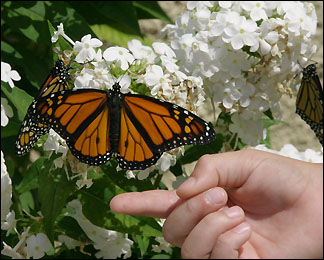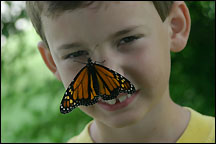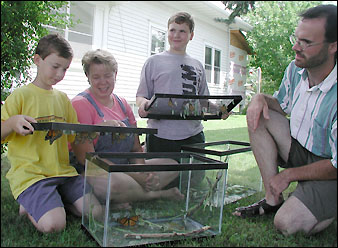Family raises, releases monarch butterflies
 Raising - and releasing - monarch butterflies helps their sons learn about nature, discover the life cycle, and become interested in knowing more, Julie and Tim Brown agree.
Raising - and releasing - monarch butterflies helps their sons learn about nature, discover the life cycle, and become interested in knowing more, Julie and Tim Brown agree.As a family project, the Browns find butterfly eggs in the countryside, in patches of milkweed in road ditches. Tim drives the family van, and Julie, Ethan, and Seth find the eggs. "We look for these little white specks," explained Ethan, 10, who will be a fifth grader at PAES this fall. "They're no bigger than a pin head. We take the whole leaf, otherwise we'd crush them."
Monarch butterflies are migratory, flying as far as Mexico and laying up to 400 eggs along the way. Because their caterpillars only eat milkweed, monarch butterflies only lay their eggs on milkweed, so their offspring will have an instant source of food.
When the Browns get home with the milkweed and eggs, they take the milkweed and place them on a cookie sheet, using wet paper towels to keep the leafs and the eggs moist. If a leaf has more than one egg, they carefully transplant one egg onto another leaf. Then they put the milkweed and the eggs in an aquarium and wait for them to hatch.
When the caterpillars are born, they look like strands of hair, said Seth, 7. "If you don't know what you're looking for, you wouldn't know (what they are)," said Julie.
 (The Browns got the idea for raising butterflies from a magazine that showed the steps and the stages of the caterpillars. Still, the first year that they tried to do it, their book knowledge was insufficient. Instead of caterpillars, when the eggs opened, they had 90 spiders!)
(The Browns got the idea for raising butterflies from a magazine that showed the steps and the stages of the caterpillars. Still, the first year that they tried to do it, their book knowledge was insufficient. Instead of caterpillars, when the eggs opened, they had 90 spiders!)
Once the half-inch caterpillars come out of their eggs, they start eating milkweed and grow to two or three inches in a few days. This keeps the Browns in constant need of more milkweed, and in finding more milkweed they typically find more eggs. "Sometimes they don't really go to get eggs," said Tim. "They need more milkweed to feed the caterpillars."
For instance, this June, they started with 63 eggs, but they have now raised and released nearly 120 monarch butterflies, their most ever. The have tried to name the butterflies - including after the U.S. presidents last year - but had too many butterflies even to try this year.
Raising butterflies "becomes a passion," said Julie. "It's just an amazing process."
From a teeny tiny egg, you watch a caterpillar be born and grow. Then you see it attach its hind legs to the top of the aquarium, see its body split, and see the chrysalis emerge from its body. "The chrysalis is inside their body," said Tim. "To me, their body turns to gel, and God makes a butterfly."
 When the butterflies emerge from the chrysalis (after a week or so, depending on the weather), they have a huge body and tiny wings. One of their first tasks as a butterfly is to pump that liquid into their wings. Then, after their wings dry in a couple hours, they are ready to fly away.
When the butterflies emerge from the chrysalis (after a week or so, depending on the weather), they have a huge body and tiny wings. One of their first tasks as a butterfly is to pump that liquid into their wings. Then, after their wings dry in a couple hours, they are ready to fly away.
"As soon as their wings dry, they start flapping them like that," said Ethan, pointing to a newborn butterfly in one of their two aquariums. "They get antsy," he continued, "and they start flying around the tank."
The Browns can differentiate between male and female butterflies by the scent glands on the back of the wings of the males, which are used to attract females for mating.
The Browns release the butterflies in the front yard of their house on Augusta Avenue, or they will bring them over to their neighbor's flowers.
The butterflies - because they are used to the voices of the Brown family - are not scared by human contact, said Julie. They will cling to the boys, and family members can pick them out of flowers even after they have been released.
Monarchs - which suck the nectar from flowers - taste with their feet and have a sense of taste that is 20,000 times more sensitive than humans, said Julie.
Because the butterflies are migratory, Julie is interested in tagging theirs to see if any come back...or just to learn if any one else finds one of their butterflies and tries to contact their family.
Seth's favorite part about raising butterflies is seeing the butterflies come out of the chrysalis. Ethan's is watching the caterpillars make the chrysalis and helping nature. Julie's is picking the eggs. Tim's is releasing the butterflies and watching their first flight.
The worst part about raising monarch butterflies, the family agrees, is cleaning the aquarium, which needs to be done frequently. "Obviously, if (the caterpillars) eat, eat, eat," said Julie, "they..."
"...poop, poop, poop," finished Tim and Ethan in unison.
The Browns also have a cat and a skink lizard. In the past, they have also kept turtles and field mice as pets. And they have started some of their friends in raising monarch butterflies, too.
Contact the author at editor@paynesvillepress.com • Return to News Menu
Home | Marketplace | Community